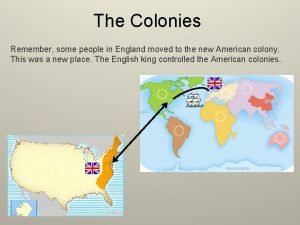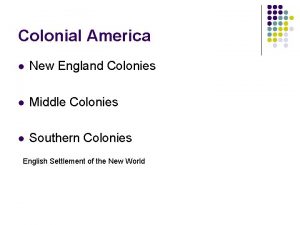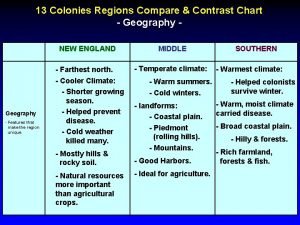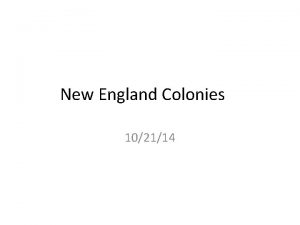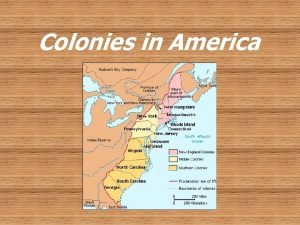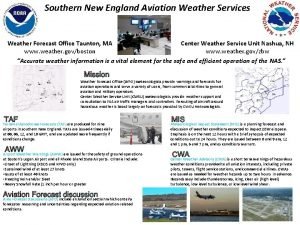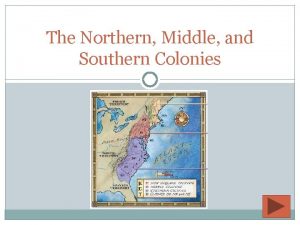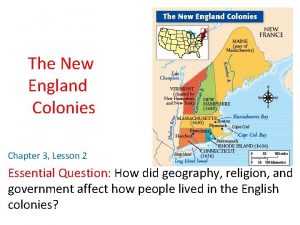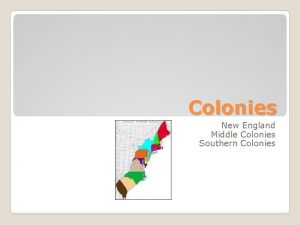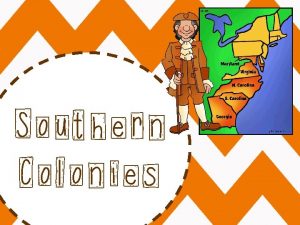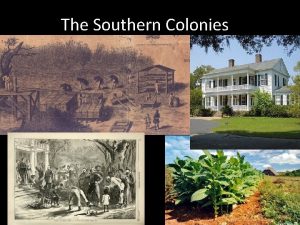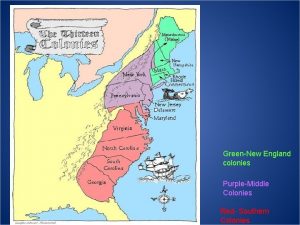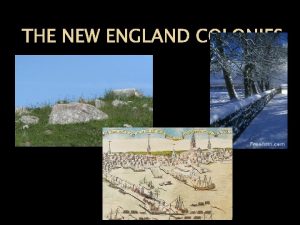New England Colonies I Southern Colonies Virginia Maryland








- Slides: 8

New England Colonies

I. Southern Colonies: (Virginia, Maryland, North Carolina, South Carolina, Georgia) / / Jamestown, Virginia was the first English colony established in 1607 Who were the Jamestown colonists? / / Men Upper class gentleman Poor indentured servants from Europe who were sent to work for gentleman Why did the first Jamestown colonists come to America? / / Looking for gold and land. But, there was no gold Began farming cash crops like tobacco for large profits

Southern Colonies: Continued I. / / / Economy: Large farms called plantations produced cash crops to sell overseas in Europe. Religion: Catholic and Church of England Political: Only landowning males could vote

I. New England Colonies: (Massachusetts, Rhode Island, Connecticut, New Hampshire, Maine) / / / Plymouth, Massachusetts was established in 1620 Mayflower Compact: Contract that established Plymouth Colony as a self-governing colony with little English involvement or influence. Who were the Massachusetts colonists? / Families (men, women, and children) / Puritans: English Christians who wished to “purify” the traditions of the Church of England / Pilgrims: religious beliefs inspired them to travel to another place to establish a more righteous home. / Religious Freedom

I. / / New England Colonies: Continued Why did the Massachusetts colonists come to America? / Puritans want to create a more “pure” society where they can freely practice their faith. Economy: They farmed to produce food for themselves. But, the land wasn’t good enough to produce cash crops for profits. Turned to trading, business, fishing and lumber for profits. Religion: / Puritans believed that everyone in their community must live a moral life or their whole community would suffer god’s wrath. / Believed that all men, women, and children must read so they can study the bible. Political: Only male churchgoers could vote

I. New England Colonies: Continued / Dissenters: Some people disagreed with Puritan Church. People who disagree with a common belief are called “dissenters. In Puritan society dissenters were often exiled (forced to move to other colonies) / Roger Williams: Believed in separation of church and state; believed colonists had no right to take Indian land / Anne Hutchinson: Believed worshipers didn’t need a church or a minister; believed each individual can have a personal relationship with god.

Map of Colonies / New England Colonies: 2 nd English Colony in Plymouth (Massachusetts) / / Established 1620 Southern Colonies: 1 st English Colony in Jamestown (Virginia) / Established 1607

Now Complete the Thought Questions… 1. 2. 3. 4. Why did the Pilgrims/Puritans migrate to America? The New England colonies had higher survival rates than Jamestown did in its first 5 -10 years. Based on what you read above, predict why the New England colonies might have been more successful. What are the two most important differences between the Southern colonies and the New England colonies? Explain your answer. Why were some colonists forced out of the Massachusetts Bay colony?
 13 colonies new england middle and southern
13 colonies new england middle and southern Northern middle and southern colonies venn diagram
Northern middle and southern colonies venn diagram 13 colonies religion chart
13 colonies religion chart New england, middle and southern colonies comparison chart
New england, middle and southern colonies comparison chart New england region
New england region New england confederation participants
New england confederation participants National weather service pensacola
National weather service pensacola Northern middle and southern colonies
Northern middle and southern colonies Where is plymouth
Where is plymouth
